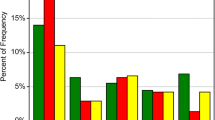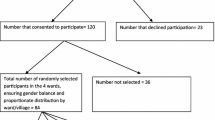Abstract
Introduction
The purpose of present study was to investigate eye care behaviors based on the BASNEF model and Health Locus of Control (HLOC) in patients with type 2 diabetes(T2D).
Methods
This cross-sectional analytical study was carried out on 150 patients with T2D in Iran in 2019. The subjects were selected using simple random sampling. The data collection tools included demographic, eye self-care behavior inventory based on BASNEF model and health locus of control whose validity and reliability were confirmed. Data analysis was carried out using Independent samples-t test ANOVA, and linear regression in SPSS ver. 24.
Result
The results of linear regression showed that knowledge, attitude, subjective norms, enabling factors, internal HLOC, chance HLOC and external HLOC were able to predict 17% of intention to eye self-care behaviors (P < 0.001) and attitude was the strongest construct in predicting intention of eye care behavior in patients with T2D (P < 0.05). In this study, most people had internal HLOC and mean (± SD) of their internal construct was 27.42(± 2.73). Also, the enabling factors construct showed a significant correlation with the internal HLOC (r = 0.283) and behavioral intention (r = 0.348) (P < 0.001).
Conclusion
The results of this study showed that attitude and enabling factors are effective constructs in predicting the intention to perform preventive behaviors of ocular complications in T2D patients. Therefore, it is recommended to organize training classes, access resources, and educational information, facilitate access to physicians for eye examinations, create new skills for care and prevention of ocular complications.
Similar content being viewed by others
Abbreviations
- HLOC:
-
Health Locus of Control
- T2D:
-
Type 2 diabetes
References
American Diabetes A. Diagnosis and classification of diabetes mellitus. Diabetes Care. 2013;36(Suppl 1):S67–74. https://doi.org/10.2337/dc13-S067.
Organization WH. The top 10 causes of death World Health Organization. Diakses dari http://www.who.int/en/news-room/factsheets/detail/the-top-10 …; 2017.
Pearce I, Simo R, Lovestam-Adrian M, Wong DT, Evans M. Association between diabetic eye disease and other complications of diabetes: implications for care. A systematic review. Diabetes Obes Metab. 2019;21(3):467–78. https://doi.org/10.1111/dom.13550.
Flaxman SR, Bourne RR, Resnikoff S, Ackland P, Braithwaite T, Cicinelli MV, et al. Global causes of blindness and distance vision impairment 1990–2020: a systematic review and meta-analysis. Lancet Glob Health. 2017;5(12):e1221–e34.
Cho N, Shaw J, Karuranga S, Huang Y, da Rocha FJ, Ohlrogge A, et al. IDF diabetes atlas: global estimates of diabetes prevalence for 2017 and projections for 2045. Diabetes Res Clin Pract. 2018;138:271–81.
Azar FE, Solhi M, Darabi F, Rohban A, Abolfathi M, Nejhaddadgar N. Effect of educational intervention based on PRECEDE-PROCEED model combined with self-management theory on self-care behaviors in type 2 diabetic patients. Diabetes Metab Syndr. 2018;12(6):1075-8.
Khokhar S, Sen S, Dhull C. Active-fluidics-based torsional phacoemulsification in diabetic eyes: a prospective interventional study. Indian J Ophthalmol. 2019;67(5):619–24. https://doi.org/10.4103/ijo.IJO_1146_18.
Vieira-Potter VJ, Karamichos D, Lee DJ. Ocular complications of diabetes and therapeutic approaches. Biomed Res Int. 2016;2016:3801570. https://doi.org/10.1155/2016/3801570.
Romero-Aroca P. Managing diabetic macular edema: the leading cause of diabetes blindness. World J Diabetes. 2011;2(6):98–104. https://doi.org/10.4239/wjd.v2.i6.98.
Dehghani-Tafti A, Mazloomy Mahmoodabad SS, Morowatisharifabad MA, Afkhami Ardakani M, Rezaeipandari H, Lotfi MH. Determinants of self-care in diabetic patients based on health belief model. Global J Health Sci. 2015;7(5):33–42. https://doi.org/10.5539/gjhs.v7n5p33.
Zhang G, Chen H, Chen W, Zhang M. Prevalence and risk factors for diabetic retinopathy in China: a multi-hospital-based cross-sectional study. Br J Ophthalmol. 2017;101(12):1591–5.
Yang J, Wang E, Zhao X, Xia S, Yuan M, Chen H, et al. Optical coherence tomography angiography analysis of the choriocapillary layer in treatment-naïve diabetic eyes. Graefes Arch Clin Exp Ophthalmol. 2019;257(7):1393–9.
Mao W, Yip CW, Chen W. Complications of diabetes in China: health system and economic implications. BMC Public Health. 2019;19(1):269. https://doi.org/10.1186/s12889-019-6569-8.
Yang Q-H, Zhang Y, Zhang X-M, Li X-R. Prevalence of diabetic retinopathy, proliferative diabetic retinopathy and non-proliferative diabetic retinopathy in Asian T2DM patients: a systematic review and meta-analysis. Int J Ophthalmol. 2019;12(2):302–11.
Liu Y, Song Y, Tao L, Qiu W, Lv H, Jiang X, et al. Prevalence of diabetic retinopathy among 13473 patients with diabetes mellitus in China: a cross-sectional epidemiological survey in six provinces. BMJ Open. 2017;7(1):e013199.
Mohammadi M, Raiegani AAV, Jalali R, Ghobadi A, Salari N. The prevalence of retinopathy among type 2 diabetic patients in Iran: a systematic review and meta-analysis. Rev Endocr Metab Disord. 2019;20(1):79–88. https://doi.org/10.1007/s11154-019-09490-3.
Lamchahab FZ, El Kihal N, Khoudri I, Chraibi A, Hassam B, Ait OM. Factors influencing the awareness of diabetic foot risks. Ann Phys Rehabil Med. 2011;54(6):359–65. https://doi.org/10.1016/j.rehab.2011.07.004.
Nathaniel GI, Adio O. Awareness and attitude of diabetic patients on diabetic eye complications in Port Harcourt, Niger J Med. 2015;24(3):252-5.
Obirikorang Y, Obirikorang C, Anto EO, Acheampong E, Batu EN, Stella AD, et al. Knowledge of complications of diabetes mellitus among patients visiting the diabetes clinic at Sampa government hospital, Ghana: a descriptive study. BMC Public Health. 2016;16:637. https://doi.org/10.1186/s12889-016-3311-7.
Rahaman KS, Majdzadeh R, Naieni KH, Raza O. Knowledge, attitude and practices (KAP) regarding chronic complications of diabetes among patients with type 2 diabetes in Dhaka. Int J Endocrinol Metab. 2017;15(3).
Smalls BL, Walker RJ, Hernandez-Tejada MA, Campbell JA, Davis KS, Egede LE. Associations between coping, diabetes knowledge, medication adherence and self-care behaviors in adults with type 2 diabetes. Gen Hosp Psychiatry. 2012;34(4):385–9. https://doi.org/10.1016/j.genhosppsych.2012.03.018.
Hazavehei SM, Khani Jeihooni A, Hasanzadeh A, Amini S. The effect of educational program based on BASNEF model for eye care in non-insulin dependent diabetic patients. J Res Health Sci. 2010;10(2):81–90.
Kumar S, Behmani RK. Health locus of control, peer pressure, and cognitive triad among adolescents. Indian Journal of Health & Wellbeing. 2017;8(1):75-81.
Kordi M, Heravan MB, Asgharipour N, Akhlaghi F, Mazloum SR. Does maternal and fetal health locus of control predict self-care behaviors among women with gestational diabetes? J Educ Health Promot. 2017;6.
Fardaza FE, Heidari H, Solhi M. Effect of educational intervention based on locus of control structure of attribution theory on self-care behavior of patients with type II diabetes. Med J Islam Repub Iran. 2017;31:116.
Mirzania M, Khajavi A, Moshki M. Validity and reliability of form C of the multidimensional health locus of control scale in pregnant women. Iran J Med Sci. 2019.
White KM, Terry DJ, Troup C, Rempel LA, Norman P, Mummery K, et al. An extended theory of planned behavior intervention for older adults with type 2 diabetes and cardiovascular disease. J Aging Phys Act. 2012;20(3):281–99.
Asadi ZS, Hosseini VM, Hashemian M, Akaberi A. Application of BASNEF model in prediction of intimate partner violence (IPV) against women. Asian Women. 2013;29(1):27–45.
Plotnikoff RC, Courneya KS, Trinh L, Karunamuni N, Sigal RJ. Aerobic physical activity and resistance training: an application of the theory of planned behavior among adults with type 2 diabetes in a random, national sample of Canadians. Int J Behav Nutr Phys Act. 2008;5(1):61.
Hrisos S, Eccles MP, Francis JJ, Bosch M, Dijkstra R, Johnston M, et al. Using psychological theory to understand the clinical management of type 2 diabetes in primary care: a comparison across two European countries. BMC Health Serv Res. 2009;9(1):140.
Ajzen I, Fishbein M. The Influence of Attitudes on Behavior. New Jersey: Lawrence Erlbaum AssociatesEditors: Mahwah; 2005. p. 173-221.
Trikkalinou A, Papazafiropoulou AK, Melidonis A. Type 2 diabetes and quality of life. World J Diabetes. 2017;8(4):120–9.
Jing X, Chen J, Dong Y, Han D, Zhao H, Wang X, et al. Related factors of quality of life of type 2 diabetes patients: a systematic review and meta-analysis. Health Qual Life Outcomes. 2018;16(1):189.
Shawon MSR, Hossain FB, Adhikary G, Gupta RD, Hashan MR, Rabbi MF, et al. Attitude towards diabetes and social and family support among type 2 diabetes patients attending a tertiary-care hospital in Bangladesh: a cross-sectional study. BMC Res Notes. 2016;9(1):286.
Glanz K, Rimer BK, Viswanath K. Health behavior: theory, research, and practice: Wiley; 2015.
Merghati SZ, Hemmati Maslak Pak M, Didarloo A, Ghareh Aghaji R. Assessment of the effect of basnef model based education on the attitudes, subjective norms, behavioral intention and enabling factors regarding healthy lifestyle in patients with heart failure. The J Urmia Nurs Midwifery Fac. 2017;14(10):822–9.
Przybylski M. Health locus of control theory in diabetes: a worthwhile approach in managing diabetic foot ulcers? J Wound Care. 2010;19(6):228–33.
Pourhoseinzadeh M, Gheibizadeh M, Moradikalboland M. The relationship between health locus of control and health behaviors in emergencymedicine personnel. Int J Community Based Nurs Midwifery. 2017;5(4):397-407.
Besen DB, Günüşen N, Sürücü HA, Koşar C. Predictor effect of locus of control (LOC) on self-care activities and metabolic control in individuals with type 2 diabetes. PeerJ. 2016;4:e2722.
Hazavehei S, Faghih solaimani P, Moeini B, Soltanian A. Factors Affecting Nutritional Behaviors of ageing population based on BASNEF Model: Sanandaj, Iran. Journal of Geriatric Nursing. 2016;2(2):61-70.
Zomahoun HTV, Moisan J, Lauzier S, Guillaumie L, Grégoire J-P, Guénette L. Predicting noninsulin antidiabetic drug adherence using a theoretical framework based on the theory of planned behavior in adults with type 2 diabetes: a prospective study. Medicine. 2016;95(15).
Lajunen T, Räsänen M. Can social psychological models be used to promote bicycle helmet use among teenagers? A comparison of the health belief model, theory of planned behavior and the locus of control. J Saf Res. 2004;35(1):115–23.
Acknowledgements
We also thank to all people who participated in this study.
Author information
Authors and Affiliations
Corresponding author
Ethics declarations
Conflict of interest
The author (s) declared no potential conflicts of interest with respect to the research, authorship, and/or publication of this article.
Human rights and animal participants
This study is based on a research project approved by the Student Research Committee of Torbat Heydariyeh University of Medical Sciences with the code of ethicsIR.THUMS.REC.1395.62. All procedures performed in this study were in accordance with the ethical standards of the institutional and/or national research committee and with the 1964 Helsinki declaration and its later amendments or comparable ethical standards. Informed consent was obtained from all individual participants included in the study.
Additional information
Publisher’s note
Springer Nature remains neutral with regard to jurisdictional claims in published maps and institutional affiliations.
Rights and permissions
About this article
Cite this article
Lael- Monfared, E., Tehrani, H., Teiho, Z. et al. The study of eye care behaviors in patients with type 2 diabetes. J Diabetes Metab Disord 19, 257–263 (2020). https://doi.org/10.1007/s40200-020-00499-z
Received:
Accepted:
Published:
Issue Date:
DOI: https://doi.org/10.1007/s40200-020-00499-z




